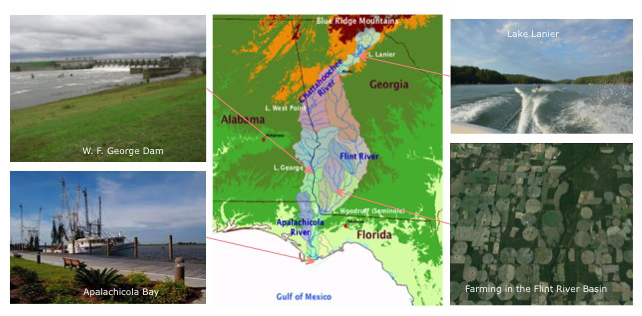 The Apalachicola-Chattahoochee-Flint river basin stretches from north Georgia to the Gulf of Mexico and serves a variety of purposes: drinking water, agriculture, navigation, recreation, energy generation and ecological functions. Research and modeling by the School's Georgia Water Resources Institute has helped a group of the watershed's stakeholders develop a comprehensive, consensus water management plan for the first time in the basin's history. (Image Courtesy of Aris Georgakakos.) |
A grassroots group of stakeholders in the three-state battle over water from the Apalachicola, Chattahoochee and Flint rivers released a consensus water management plan for the basin May 13, thanks in good measure to work by Professor Aris Georgakakos and his team.
Five years in the making, the plan will be shared with the governors of Alabama, Florida, and Georgia, as well as with the U.S. Army Corps of Engineers, in hopes of ending two decades of fighting.
The School of Civil and Environmental Engineering’s Georgia Water Resources Institute (GWRI) performed much of the data-collection and assessment work for the ACF Stakeholders (ACFS) group, including cutting-edge modeling of the river.
“This detailed modeling allowed stakeholders to analyze the current basin conditions and the impact of numerous water management alternatives — changes such as [U.S. Army Corps of Engineers] water control operations or raising reservoir levels or increased consumptive use,” said Brad Moore, chair of the ACFS technical oversight and coordination workgroup. “The insights gained from these model runs allowed the ACFS to develop recommendations that will be made to the [Corps of Engineers], state and federal agencies, and private enterprises that will benefit the basin.”
 Georgakakos |
|
 Kistenmacher |
|
“GWRI’s technical assessments led to detailed water management recommendations that form the basis of the ACF Stakeholders’ agreed-upon management plan,” said Georgakakos, a professor in the School and GWRI’s director. “GWRI demonstrated that more proactive reservoir regulation and water/energy management strategies can mitigate water stresses during droughts and increase basin-wide benefits during wetter hydrologic periods.”
Georgakakos and GWRI Assistant Director Martin Kistenmacher worked closely with the stakeholders and presented their findings in a series of meetings. One member called them the most informative and fruitful in the history of the ACF basin.
“We now have everything we need in the way of information and alternatives to be able to create a sustainable water management plan,” ACFS board member Brad Currey wrote in a letter after those meetings. “You two have put us in a place now to say that it can be done, that it is not impossible.”
The demand for water from the three rivers that make up the watershed has grown dramatically in recent decades as the population has grown steadily and droughts have stretched supply. The basin stretches across nearly 20,000 square miles from north Georgia to the Apalachicola Bay in the Florida Panhandle, serving the metro Atlanta area as well as other cities, agricultural interests in south Georgia and Alabama, energy generation, navigation, recreation, and a very diverse and sensitive ecosystem in the Apalachicola Bay.
Georgakakos said GWRI’s work in the ACF basin is emblematic of the institute’s other projects around the world, from California to the Nile River in Africa and the Yangtze River in China.
“In all regions it is involved, GWRI strives to improve the science and practice of water resources planning and management in ways that balance quality of life, environmental sustainability, and economic growth,” he said.
Read more about the sustainable water management plan ACF Stakeholders released this week.
(Teaser image: Chattahoochee River at Peachtree Corners, Georgia. Photo Courtesy of Mike Gonzalez via Wikimedia Commons.)

